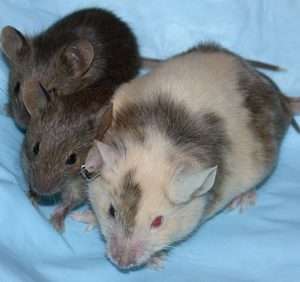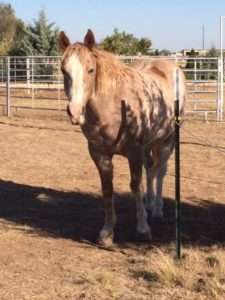The variety of coloration in mammals never ceases to amaze me. In spite of the fact that we have fewer colors available to us than birds or reptiles, we still display the pigments we have in a wide array of patterns.

Sometimes the genetics behind certain patterns absolutely fascinates me. For example, horse color genetics gets incredibly complex the more you dive into it, with dilution genes, leopard complexes, and other modifying factors that can completely shift a horse’s coat from what the normal base color would be into something quite different.
Occasionally you’ll get a horse that has a large patch or two of a darker color than the rest of its body. It may be tempting to assume you have a chimera, in which two or more embryos combined in the uterus during development, but only one offspring was produced. Genetic testing, however, shows that the DNA in all parts of the horse is the same.

Chimerism is exceedingly rare, though, and it’s much more likely that the horse is displaying a somatic mutation. There are two types of cells in a multicellular being: germ cells are the reproductive cells that pass on genetic material, while all the other cells are somatic cells. Normally the way an organism is put together, to include colors, is completely mapped out in the genes held in the germ cells.
But occasionally, somatic cells will undergo a mutation after the organism after it has been conceived. One cell experiences the mutation, and then as it divides its daughter cells carry the mutation as well. Somatic mutations may occur anytime after conception, to include postnatal mutations; some of them are due to environmental factors such as exposure to toxins, infections, or UV light. In fact, some cancers are examples of somatic mutations that may occur any time through the life cycle.
Somatic mutation can even lead to genetic mosaicism if there was an error in a cell, especially early in the organism’s development; the fully formed organism then has sections of its body that are of one genotype, and other sections that show a second, distinct genotype.

Thankfully, in the case of somatic mutations that affect horse colors, these are generally not harmful to the horse. They can however, create some very interesting patterns. An online search for “somatic mutations in horses” brings up a great variety of image results.
So that’s horses. But what about cats? Specifically, calico cats? These are an example of yet another delightfully weird genetic phenomenon.
Cats, like humans, usually have either XX or XY chromosomes. And the vast majority of calico cats are XX female (oddly enough, most orange tabbies are XY male.) This is because the gene for fur color is carried on the X chromosome. XX calico cats have two X chromosomes in each cell, one with the gene for orange fur and one with the gene for black fur. One the zygote reaches eight cells, each one turns off one of its two X chromosomes. If the chromosome with the black gene is turned off, that cell will then produce orange fur, as will its daughter cells, and vice versa.
 Which X chromosome gets turned off is completely random. This is why you have calicos with varied patches of orange and black on a white background, and two calicos from the same litter may look very, very different from each other.
Which X chromosome gets turned off is completely random. This is why you have calicos with varied patches of orange and black on a white background, and two calicos from the same litter may look very, very different from each other.
Oh, and the rare male calico? This oddity is the feline equivalent of Klinefelter’s syndrome. Instead of being XY male, the cat actually has two X chromosomes and one Y chromosomes, making it an XXY male.
There are plenty of other examples of weird color genetics in animals and other beings, but those will have to wait for another post at another time.
